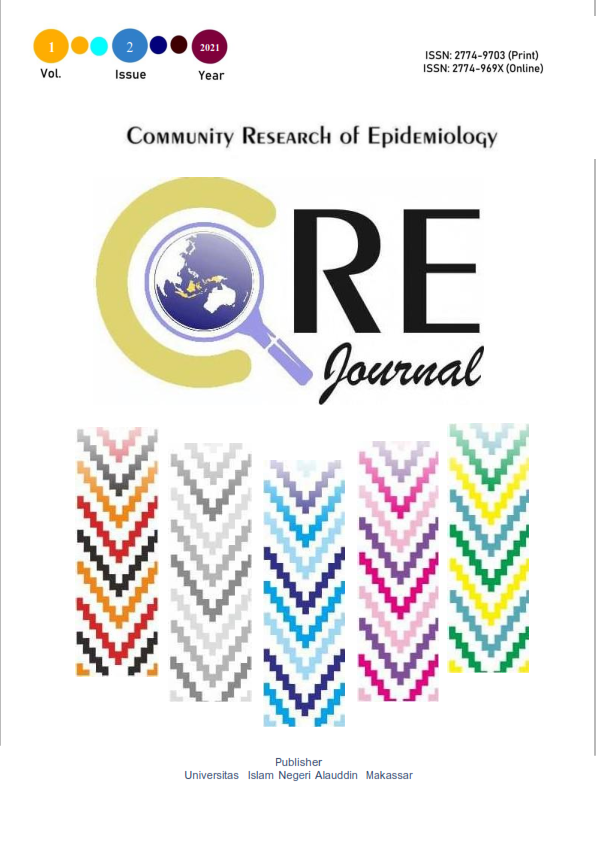Characteristics of Presbyopia Patients at Eye Health Center Makassar
Abstract
Presbyopia is a visual disorder related to age. It occurs lens stiffness with adding the age in presbyopia in order to lens ability to focus shadow when looking can be near. This research aimed to know the characteristics of presbyopia patients at eye health center Makassar in the period of January-December 2018. The research design is a descriptive study using secondary data. The number of samples in this study were 97 medical record data selected by purposive sampling and analyzed by univariate and bivariate. The results showed that as many as 97 patients, the majority were 64 women (34%), the majority of the presbyopia were at the age of 40-45 years as many as 23 people (23.7%). Based on the characteristics of the presbyope patient, there were 48 patients (49.5%) suffering from hypermetropic presbyopia, while 18 patients (18.5%) suffered from other presbyopes such as premature presbyopia (early). It is hoped that the provision of information about presbyopia can be scientific support for the optometrist practice program.
References
American Academy of Ophthalmology, (2009). Frequency of Ocular Examination. http://www.aao.org/clinical-statement/frequency-of-ocular-examinations--november-2009 [diakses 28 April 2018].
Badan Penelitian dan Pengembangan Kesehatan Kementerian Kesehatan Republik Indonesia. (2013). Riset Kesehatan Dasar. Riskesdas 2013. 1 Desember 2013. http://labmandat.litbang.depkes.go.id
Balai Kesehatan Mata Makassar (2018). Data Tindakan Operasi BKMM. BKMM 2019.
Balai Kesehatan Mata Makassar (2018). Data Rekam Medik BKMM. BKMM 2019.
Balai Kesehatan Mata Makassar (2018). Profil Kunjungan dan Tindakan Operasi BKMM. BKMM 2019.
Costanzo, L.S. (2012). Essential Fisiologi Kedokteran. Edisi Kelima. Binarupa Aksara. 73.
Emerole C.G.1,, NneliR. O.,Osim E. E. (2014) Presbyopia: Prevalence, distribution and determinants in Owerri, Nigeria. J Exp Clin Anat 2014;13:21-5
Gajapati, C. V., Pradeep, A. V., Kakhandaki, A., Praveenchandra, R. K., & Rao, S. (2017). Awareness of Presbyopia among Rural Female Population in North Karnataka. Journal of clinical and diagnostic research : JCDR, 11(9), NC01–NC05. https://doi.org/10.7860/JCDR/2017/26125.10608
Grosvenor T. Goss D.A., (1999) Clinical management of myopia, Butterworth-Heinemann, p. 163 "Hom MM, Manual of contact lens prescribing and fitting. Boston
Holden A.B. (2007). Uncorrected refractive error: The major and most easily avoidable cause of vision loss. Community Eye Health J 20 (63):37-9
Kementerian Kesehatan RI. (2015). Info datin Pusat Data dan InformasimKementerian Kesehatan RI. Situasi Gangguan Penglihatan dan Kebutaan. Jakarta Selatan.
Laviers H., Omar F., Jecha H., Kassim G., Gilbert C. (2010). Presbyopic spectacle coverage, willingness to pay for near correction and the impact of correcting uncorrected presbyopia in adults in Zanzibar, East Africa. Invest Ophthalmol Vis Sci 51 (2):1234‑ 41.
Nirmalan, P. K., Krishnaiah, S., Shamanna, B. R., Rao, G. N., & Thomas, R. (2006). A population-based assessment of presbyopia in the state of Andhra Pradesh, south India: the Andhra Pradesh Eye Disease Study. Investigative ophthalmology & visual science, 47(6), 2324–2328.
Patel, I., & West, S. K. (2007). Presbyopia: prevalence, impact, and interventions. Community eye health, 20(63), 40–41.
WHO. (2009). What is a refractive error?. http//www.who.int/feature/qa/45/en/. [diakses 28 Juni 2019].


